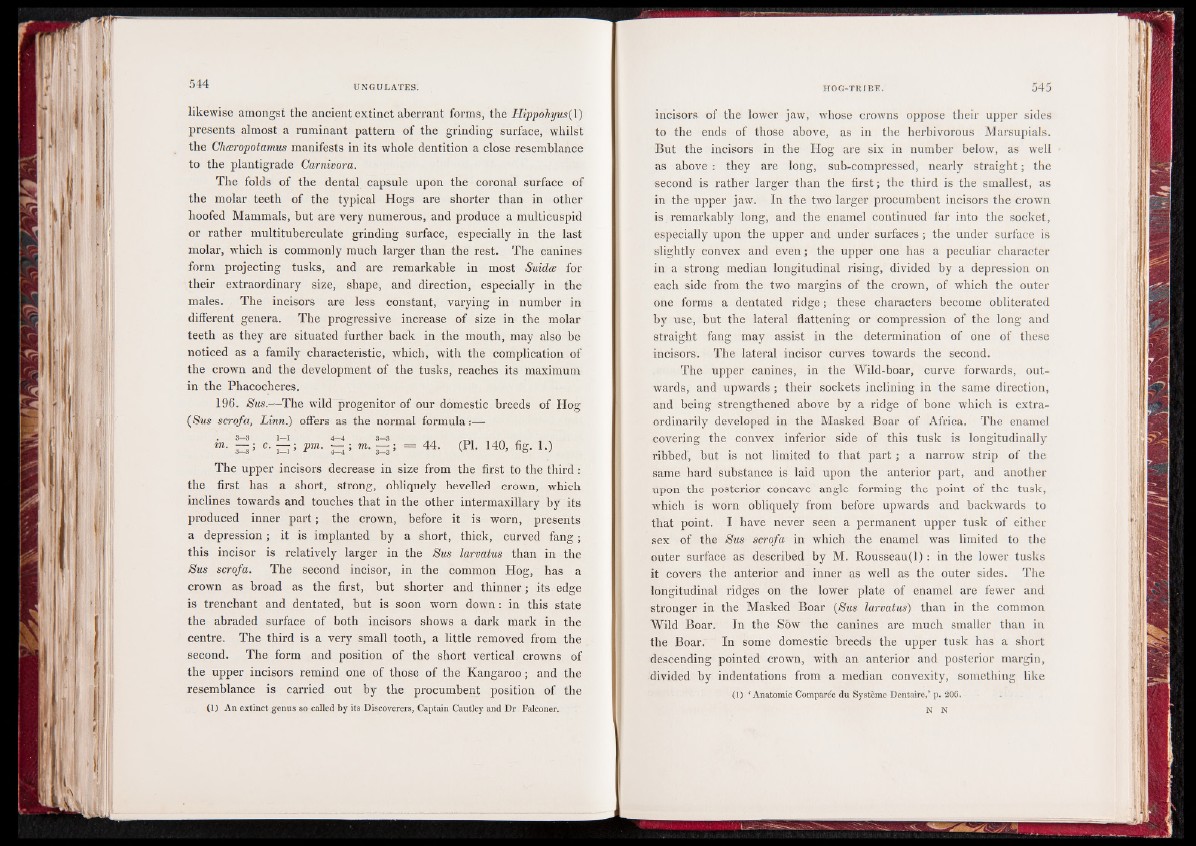
likewise amongst the ancient extinct aberrant forms, the Hippohyus(\)
presents almost a ruminant pattern of the grinding surface, whilst
the Chocropotamus manifests in its whole dentition a close resemblance
to the plantigrade Carnivora.
The folds of the dental capsule upon the coronal surface of
the molar teeth of the typical Hogs are shorter than in other
hoofed Mammals, but are very numerous, and produce a multicuspid
or rather multituberculate grinding surface, especially in the last
molar, which is commonly much larger than the rest. The canines
form projecting tusks, and are remarkable in most Saida: for
their extraordinary size, shape, and direction, especially in the
males. The incisors are less constant, varying in number in
different genera. The progressive increase of size in the molar
teeth as they are situated further back in the mouth, may also be
noticed as a family characteristic, which, with the complication of
the crown and the development of the tusks, reaches its maximum
in the Phacocheres.
196. Sus.—The wild progenitor of our domestic breeds of Hog
(Sus scrofa, Linn.) offers as the normal formula:—
c. —1—I : pm. 4——4 : m. 3—-3 ; = 44. 1—1 ’ 1 4—4 ’ 3—3 • (PI. 140, fig. 1.)
The upper incisors decrease in size from the first to the third:
the first has a short, strong, obliquely bevelled crown, which
inclines towards and touches that in the other intermaxillary by its
produced inner part; the crown, before it is worn, presents
a depression; it is implanted by a short, thick, curved fang;
this incisor is relatively larger in the Sus larvatus than in the
Sus scrofa. The second incisor, in the common Hog, has a
crown as broad as the first, hut shorter and thinner; its edge
is trenchant and dentated, hut is soon worn down: in this state
the abraded surface of both incisors shows a dark mark in the
centre. The third is a very small tooth, a little removed from the
second. The form and position of the short vertical crowns, of
the upper incisors remind one of those of the Kangaroo; and the
resemblance is carried out by the procumbent position of the
(1) An extinct genus so called by its Discoverers, Captain Cautley and Dr Falconer.
incisors of the lower jaw, whose crowns oppose their upper sides
to the ends of those above, as in the herbivorous Marsupials.
But the incisors in the Hog are six in number below, as well
as above : they are long, sub-compressed, nearly straight ; the
second is rather larger than the first; the third is the smallest, as
in the upper jaw. In the two larger procumbent incisors the crown
is remarkably long, and the enamel continued far into the socket,
especially upon the upper and under surfaces ; the under surface is
slightly convex and even ; the upper one has a peculiar character
in a strong median longitudinal rising, divided by a depression on
each side from the two margins of the crown, of which the outer
one forms a dentated ridge ; these characters become obliterated
by use, but the lateral flattening or compression of the long and
straight fang may assist in the determination of one of these
incisors. The lateral incisor curves towards the second.
The upper canines, in the Wild-boar, curve forwards, outwards,
and upwards ; their sockets inclining in the same direction,
and being strengthened above by a ridge of bone which is extraordinarily
developed in the Masked Boar of Africa. The enamel
covering the convex inferior side of this tusk is longitudinally
ribbed, but is not limited to that part ; a narrow strip of the
same hard substance is laid upon the anterior part, and another
upon the posterior concave angle forming the point of the tusk,
which is worn obliquely from before upwards and backwards to
that point. I have never seen a permanent upper tusk of either
sex of the Sus scrofa in which the enamel was limited to the
outer surface as described by M. Rousseau(l) : in the lower tusks
it covers the anterior and inner as well as the outer sides. The
longitudinal ridges on the lower plate of enamel are fewer and
stronger in the Masked Boar (Sus larvatus) than in the common
Wild Boar. In the Sow the canines are much smaller than in
the Boar. In some domestic breeds the upper tusk has a short
descending pointed crown, with an anterior and posterior margin,
divided by indentations from a median convexity, something like
(1) ‘Anatomie Comparée du Système Dentaire/p. 206.
N N